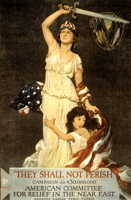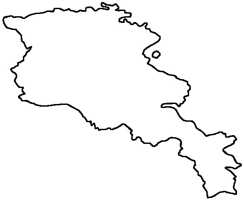
|
The Society of Folk Dance Historians (SFDH)
Armenian History and Culture
[
Home |
About |
Encyclopedia | CLICK AN IMAGE TO ENLARGE |

|
 The legendary history of Armenia begins around 2300 BCE with Haik, Son of Togarak, the great great grandson of Noah. He is said to have taken refuge in Armenia from the tyranny of Blus, King of Babylon. The Armenians call themselves Hai (from Halik). Maybe Americans don't realize that when they great each other with "hi," they are practically saying something in Armenian.
The legendary history of Armenia begins around 2300 BCE with Haik, Son of Togarak, the great great grandson of Noah. He is said to have taken refuge in Armenia from the tyranny of Blus, King of Babylon. The Armenians call themselves Hai (from Halik). Maybe Americans don't realize that when they great each other with "hi," they are practically saying something in Armenian.
Armenian people have nearly a 3000 year history of language and culture. By 700 BCE, the Armenian political and military power was achieved under the reign of King Tigranes the Great. Armenia extended from the shores of the Caspian Sea in the east and to the Mediterranean Sea in the west. The powerful Roman Empire to the west marshaled it's military and reduced the American territory.
During the first five centuries CE, the contry embraced Christianity and adopted a national alphabet of thirty-six letters.
In the 11th century, a major invasion occurred when Seljuk Turks invaded Armenia. The years 1200 to 1900 were dark ones for Armenians. During that time, the Armenians had no government of their own, no schools, no freedom. The Armenians lived in Armenia but Armenia did not belong to them.
There were protests from many European countries asking that the Turks treat Christians, especially Armenians, more humanely but their protests were ignored. During World War I, from 1914 to 1916, on the pretext that they were supporting the Allies (Turkey's enemies), the Turkish government massacred many Armenians. Two million Armenians were driven from their homes, their properties and businesses confiscated. As a two year old boy I was among them. They were forced to march into the Syrian Desert where 1.5 million died or were slain, my father included.
After so much persecution, do you wonder that Armenians escaped and immigrated to any country that would accept them? Before World War I, 2.4 million Armenians were living in Turkey. Today it is estimated that there are just 200,000, many of whom have changed their names and religion in order to survive.
 It is interesting to note that in this year, 1987, the European Ecumenical Council refused membership to Turkey "until the Turkish government recognizes the massacre of the Armenians, the first massacre of the 20th century." I don't believe Armenians demand recognition from the Turkish government that the massacre did happen, so that in the future stories of mankind, Turks will not massacre Armenians, Germans will not massacre Jews, and there will not be a repeat of such atrocities to any nation by any other nation.
It is interesting to note that in this year, 1987, the European Ecumenical Council refused membership to Turkey "until the Turkish government recognizes the massacre of the Armenians, the first massacre of the 20th century." I don't believe Armenians demand recognition from the Turkish government that the massacre did happen, so that in the future stories of mankind, Turks will not massacre Armenians, Germans will not massacre Jews, and there will not be a repeat of such atrocities to any nation by any other nation.
My life in many ways reflects Armenian suffering. From the age of two (I don't remember my father) I was in exile in terror in Turkey with no adequate clothing, often barefoot, and always hungry, with no place to sleep in the bitter, cold winters, I was constantly forced to move from city to city, therefore getting no schooling. For Armenian students, there is no such thing as 10th, 20th, or 50th class reunions. My mother, who was also father to her three boys, took us to Soviet Armenia in 1927 where I attended school and ultimately graduated from the University of Electronics and Acoustics in Odessa, Ukraine in 1939.
In Armenia I joined the Government Dance and Song Ensemble, often participating in performances, sometimes as a solo dancer, with Armenian, Georgian, and some Russian dances. Later, I actively participated in European dances.
Every country has its characteristic culture and Armenia is no exception. Much of western Armenian culture is related to the culture of neighboring countries. For example, Armenian poetry is related to Persia and the food and customs are similar to the Mediterranean region. For centuries, Armenia was occupied by the Roman Empire, Persians, Byzantines, and Greeks. Each nation had an influence on the culture and economy of Armenia. It is certain that they mutually influenced each other's cultures, music, and cooking. For example, often the dances and the music are the same as Armenian, Turkish, and even Greek. Only the vocabulary is different.
Armenian dances are different in Turkish Armenia (west) and the Caucasus (east). East Armenian dances are not influenced by the Turks or Mediterranean countries but have a real ethnic Armenian character going back thousands of years. Armenians dance at any festivity, especially weddings, where young men, by eye contact, "meet" young women from a distance only. There is no hand holding. A young man will invite a young woman through dance only, the first fire of love is begun . . .
The immigrants brought their dances to the United States, but with freedom of expression in the country. The true Armenian dances were modified and went through great changes. Now, a new artistic flow is coming to these shores from Soviet Armenia. Teachers are trying to keep the Armenian ethnicity of the dances. Even in Armenia, dances are changing to a more modern form. For instance, Daranec and Eloo Yar, where a man and a woman now hold hands.
Armenians began arriving in the United States in the early part of the 19th century. Many immigrants from many different nations came to this blessed country for better economic conditions, but after becoming rich they returned to their original country. The Armenians were different. They immigrated to the United States to escape Turkish tyranny and they remained here.
The first Armenian settlement on the West coast began in Fresno, California in 1881. Fresno and Los Angeles have the largest Armenian communities. There are close to one million Armenians residing in the United States today.
For non-Armenians to get involved with Armenian culture and dance, I recommend contacting the Armenian church in your locality. There you may join in the dancing at any festivities, and one thing is sure – you will find warm hospitality and good food!
DOCUMENTS
- Armenia, a country
- Armenia and the Armenians, an article.
- Armenian Dance, an article.
- Armenian Dance History, an article.
- Armenian Dancing, an article.
- Armenian Folk Dance Types, an article
- Armenian Question, an article.
- Peoples of the North Caucasus, an article
- Transcaucasia, a region.
Printed in Folk Dance Scene, September 1987.
This page © 2018 by Ron Houston.
Please do not copy any part of this page without including this copyright notice.
Please do not copy small portions out of context.
Please do not copy large portions without permission from Ron Houston.